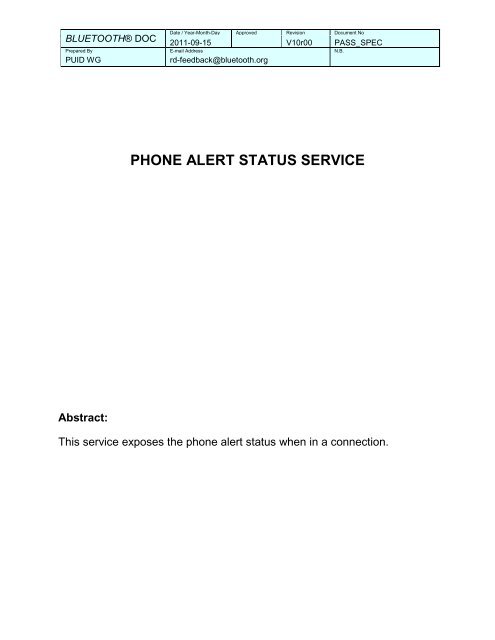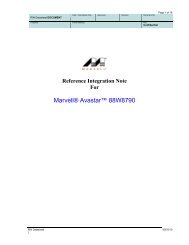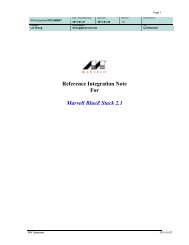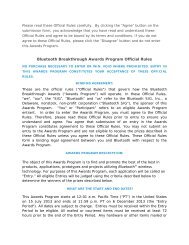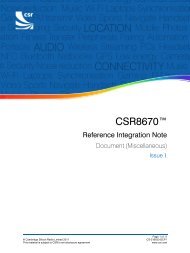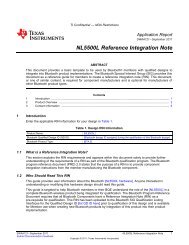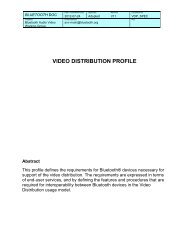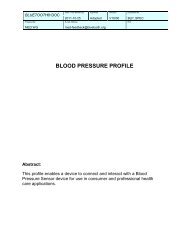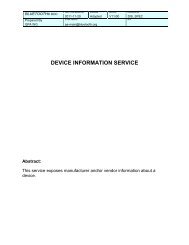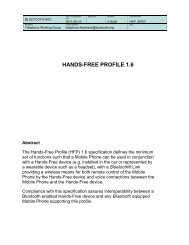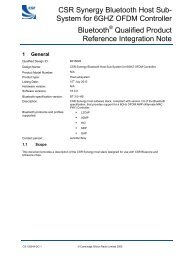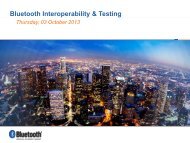phone alert status service - Bluetooth Development Portal
phone alert status service - Bluetooth Development Portal
phone alert status service - Bluetooth Development Portal
- No tags were found...
Create successful ePaper yourself
Turn your PDF publications into a flip-book with our unique Google optimized e-Paper software.
BLUETOOTH® DOCDate / Year-Month-Day Approved Revision Document No2011-09-15 V10r00 PASS_SPECPrepared By E-mail Address N.B.PUID WGrd-feedback@bluetooth.orgPHONE ALERT STATUS SERVICEAbstract:This <strong>service</strong> exposes the <strong>phone</strong> <strong>alert</strong> <strong>status</strong> when in a connection.
BLUETOOTH SPECIFICATION Page 2 of 13Phone Alert Status ServiceRevision HistoryRevision Date (yyyy-mm-dd) CommentsD09r01 2011-01-21 First DraftD09r02 2011-03-02 Eliminated indication/indicate, added BR/EDRD09r03 2011-05-13 Updated based on the latest UCRDD(D05r12)D09r04 2011-06-11 Removed BR/EDR and corrected some cut/paste issuesD09r05 2011-06-28 Resolved comments from Kanji and TerryD09r06 2011-07-04 Added that undefined commands have no action.D09r07 2011-07-07 Incorporated comments from Miles (BTI) and Jason (GPA) andHuanchun (GPA/BARB)D09r08 2011-07-08 Inserted correct Disclaimers and Copyright noticeD09r09 2011-07-14 Two editorial changes proposed by Tim HowesV09r00 2011-07-26 Adopted as PS by the <strong>Bluetooth</strong> SIG Board of DirectorsD10r01 2011-08-09 First draft D10D10r02 2011-08-10 Added Service to the <strong>service</strong> UUID name.Technical: Added text to avoid “Mute Once” credits when issuedwhen there is no ringingD10r03 2011-08-17 Removed PS disclaimer. Two more editorial comments (by AB)resolvedD10r04 2011-08-29 Responded to comments from JL. After WG review, resulted incommands being optional (and the control point being optional)V10r00 2011-09-15 Adopted by the <strong>Bluetooth</strong> SIG Board of DirectorsContributorsNameShunsuke KoyamaOshiyama SatoshiSadao NagashimaDaisuke MatsuohFrank BerntsenCompanySeiko EpsonSeiko EpsonCasioCitizenNordic Semiconductor
BLUETOOTH SPECIFICATION Page 4 of 13Phone Alert Status ServiceDocument TerminologyThe <strong>Bluetooth</strong> SIG has adopted Section 13.1 of the IEEE Standards Style Manual,which dictates use of the words ``shall’’, ``should’’, ``may’’, and ``can’’ in thedevelopment of documentation, as follows:The word shall is used to indicate mandatory requirements strictly to be followed inorder to conform to the standard and from which no deviation is permitted (shall equalsis required to).The use of the word must is deprecated and shall not be used when stating mandatoryrequirements; must is used only to describe unavoidable situations.The use of the word will is deprecated and shall not be used when stating mandatoryrequirements; will is only used in statements of fact.The word should is used to indicate that among several possibilities one isrecommended as particularly suitable, without mentioning or excluding others; or that acertain course of action is preferred but not necessarily required; or that (in the negativeform) a certain course of action is deprecated but not prohibited (should equals isrecommended that).The word may is used to indicate a course of action permissible within the limits of thestandard (may equals is permitted).The word can is used for statements of possibility and capability, whether material,physical, or causal (can equals is able to).
BLUETOOTH SPECIFICATION Page 5 of 13Phone Alert Status ServiceTable of Contents1 Introduction .................................................................................................................................... 61.1 Conformance ............................................................................................................................. 61.2 Service Dependency ................................................................................................................. 61.3 <strong>Bluetooth</strong> Specification Release Compatibility .......................................................................... 61.4 GATT Sub-Procedure Requirements ........................................................................................ 61.5 Transport Dependencies ........................................................................................................... 61.6 Error Codes ............................................................................................................................... 62 Service Declaration ........................................................................................................................ 73 Service Characteristics ................................................................................................................. 83.1 Alert Status ................................................................................................................................ 93.1.1 Characteristic Behavior ....................................................................................................... 93.1.2 Characteristic Descriptors ................................................................................................... 93.1.2.1 Client Characteristic Descriptor .................................................................................... 93.2 Ringer Setting ............................................................................................................................ 93.2.1 Characteristic Behavior ....................................................................................................... 93.2.2 Characteristic Descriptors ................................................................................................... 93.2.2.1 Client Characteristic Descriptor .................................................................................... 93.3 Ringer Control Point ................................................................................................................ 103.3.1 Characteristic Behavior ..................................................................................................... 104 Service Behavior .......................................................................................................................... 115 Acronyms and Abbreviations ..................................................................................................... 126 References .................................................................................................................................... 13
BLUETOOTH SPECIFICATION Page 6 of 13Phone Alert Status Service1 IntroductionThe Phone Alert Status <strong>service</strong> uses the Alert Status characteristic and Ringer Settingcharacteristic to expose the <strong>phone</strong> <strong>alert</strong> <strong>status</strong> and uses the Ringer Control Pointcharacteristic to control the <strong>phone</strong>’s ringer into mute or enable.1.1 ConformanceIf a server claims conformance to this <strong>service</strong>, all capabilities indicated as mandatory forthis <strong>service</strong> shall be supported in the specified manner (process-mandatory). This alsoapplies for all optional and conditional capabilities for which support is indicated. Allmandatory capabilities, and optional and conditional capabilities for which support isindicated, are subject to verification as part of the <strong>Bluetooth</strong> qualification program.1.2 Service DependencyThis <strong>service</strong> has no dependencies on other GATT-based <strong>service</strong>s.1.3 <strong>Bluetooth</strong> Specification Release CompatibilityThis <strong>service</strong> is compatible with any <strong>Bluetooth</strong> core specification that includes theGeneric Attribute Profile (GATT).1.4 GATT Sub-Procedure RequirementsAdditional GATT sub-procedures requirements beyond those required by the GATT areindicated in Table 1.1.GATT Sub-ProcedureWrite Without ResponseNotificationRead Characteristic DescriptorsWrite Characteristic DescriptorsTable 1.1: GATT Sub-procedure requirementsRequirementsMMMM1.5 Transport DependenciesThis <strong>service</strong> shall operate over LE transport only.1.6 Error CodesThis <strong>service</strong> does not define any application error codes.
BLUETOOTH SPECIFICATION Page 7 of 13Phone Alert Status Service2 Service DeclarationThe Phone Alert Status <strong>service</strong> shall be instantiated as a «Primary Service». The<strong>service</strong> UUID shall be set to «Phone Alert Status Service».The UUID value assigned to «Phone Alert Status Service» is defined in [2].There shall only be one instance of the Phone Alert Status <strong>service</strong> on a device.
BroadcastReadWrite withoutResponseWriteNotifyIndicateSigned WriteReliable WriteWritableAuxiliariesBLUETOOTH SPECIFICATION Page 8 of 13Phone Alert Status Service3 Service CharacteristicsThe Phone Alert Status <strong>service</strong> shall expose the Alert Status characteristic and theRinger Setting characteristic, and may expose the Ringer Control Point characteristic asshown below:The following characteristics are exposed in the Phone Alert Status <strong>service</strong>.Characteristic Ref. Mandatory / OptionalAlert Status 3.1 MRinger Setting 3.2 MRinger Control Point 3.3 OTable 3.1: Service characteristicsThe characteristics shall comply with the properties in Table 3.2:Alert Status X M X X M X X X XRinger Setting X M X X M X X X XRinger Control Point X X M X X X X X XTable 3.2: Characteristic propertiesRequirements marked with ‘M’ are mandatory, ‘O’ are optional, and ‘X’ are excluded(not permitted).There are no security requirements specified for this <strong>service</strong>.
BLUETOOTH SPECIFICATION Page 9 of 13Phone Alert Status Service3.1 Alert Status3.1.1 Characteristic BehaviorThe Alert Status Characteristic has three fields of information that exposes the <strong>alert</strong>ing<strong>status</strong> of the server device as follows:Ringer StateVibrator StateDisplay Alert StateThe Alert Status characteristic returns the current value of server’s <strong>alert</strong> <strong>status</strong> whenread.The client characteristic configuration descriptor shall be implemented to enable a clientto configure this characteristic for notifications.3.1.2 Characteristic Descriptors3.1.2.1 Client Characteristic DescriptorThe Client Characteristic Configuration descriptor shall be included in this characteristic.This descriptor shall be readable and writable.This descriptor can be read using the GATT Read Characteristic descriptors subprocedure.This descriptor can be written using the GATT Write Characteristic descriptors subprocedure.3.2 Ringer Setting3.2.1 Characteristic BehaviorThe Ringer Setting characteristic exposes the state of the server device's ringer.The Ringer Setting characteristic returns the current value of the Ringer Setting whenread.The client characteristic configuration descriptor shall be implemented to enable a clientto configure this characteristic for notifications.3.2.2 Characteristic Descriptors3.2.2.1 Client Characteristic DescriptorThe Client Characteristic Configuration descriptor shall be included in this characteristic.This descriptor shall be readable and writable.This descriptor can be read using the GATT Read Characteristic Descriptors subprocedure.
BLUETOOTH SPECIFICATION Page 10 of 13Phone Alert Status ServiceThis descriptor can be written using the GATT Write Characteristic Descriptors subprocedure.3.3 Ringer Control Point3.3.1 Characteristic BehaviorIf the Ringer Control Point characteristic is implemented, the server device shall supportat least one of the commands in Table 3.3.CommandMandatory / OptionalSet Silent Mode C.1Cancel Silent Mode C.1Mute Once C.1C.1: Mandatory to support at least one if the Ringer Control Point characteristic isimplementedTable 3.3: Ringer Control Point commandsWhen the Ringer Control Point characteristic is written with a supported value(command), the server device shall perform an action based on the value (command).See Section 4.
BLUETOOTH SPECIFICATION Page 11 of 13Phone Alert Status Service4 Service Behavior“Silent mode”“MuteOnce”“MuteOnce”Ringer SilentRingerNormal“Silent mode”“Cancel Silent mode”“Cancel Silent mode”Table 4.1: Phone Alert Status state diagramThe server device shall implement a state machine with two states, “Ringer Silent” and“Ringer Normal”.The command “Set Silent Mode” shall set the state to “Ringer Silent”.The command “Cancel Silent Mode” shall set the state to “Ringer Normal”.The command “Mute Once” shall silence the server device’s ringer. If the ringer is notactive, the “Mute Once” command shall have no effect. The ringer state is not affectedby the “Mute Once” command.For any other command values (not defined by the characteristic specification [2]), thestate shall not change.The server device’s ringer shall be silenced when the state is “Ringer Silent” and actaccording to <strong>phone</strong> settings when the state is “Ringer Normal”.Note: The Alert Status and Ringer Setting characteristics will reflect the state of the<strong>alert</strong>ing and ringer setting of the server device. These states will normally change whenthe state machine changes or other events (like incoming call or user interaction)happens on the server device. Therefore, the client does not have direct control overthe server’s Ringer Setting through the Ringer Control Point.
BLUETOOTH SPECIFICATION Page 12 of 13Phone Alert Status Service5 Acronyms and AbbreviationsAcronyms and Abbreviations MeaningGATTGeneric Attribute ProfileLELow EnergyUUIDUniversally Unique IdentifierTable 5.1: Acronyms and Abbreviations
BLUETOOTH SPECIFICATION Page 13 of 13Phone Alert Status Service6 References[1] <strong>Bluetooth</strong> Core Specification v4.0[2] Characteristic and Descriptor descriptions are accessible via the <strong>Bluetooth</strong> SIG Assigned Numbers.


